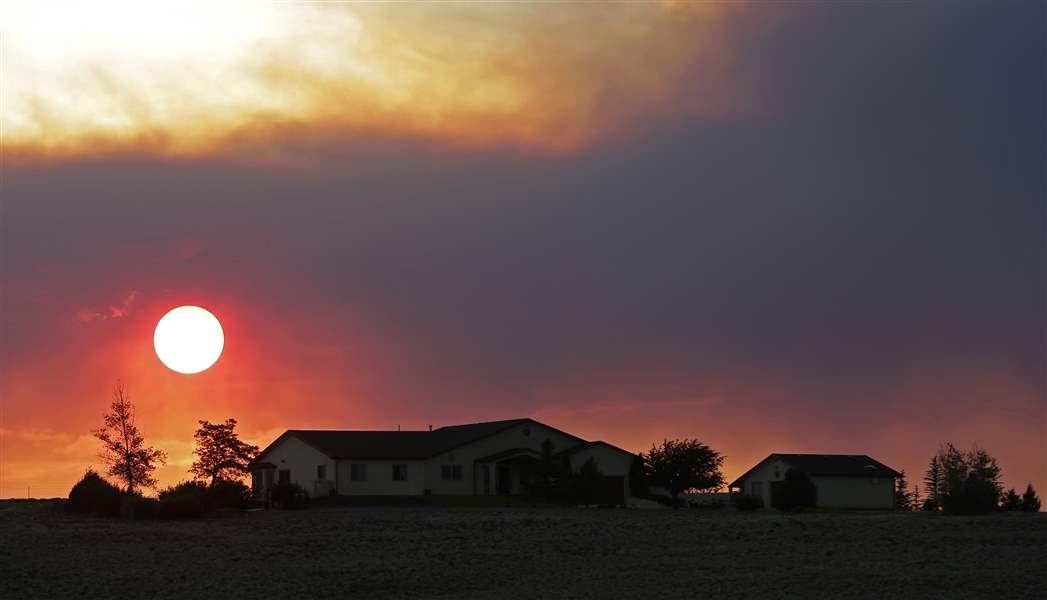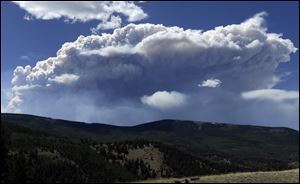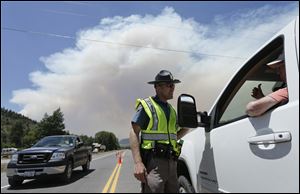
Change in weather needed at Colorado fire
6/24/2013
The sun sets through wildfire smoke near Monte Vista, Colo.
ASSOCIATED PRESS

Wildfire smoke plumes above Del Norte Peak. The fire, near a popular summer retreat in southern Colorado, continues to be driven by winds and fueled by dead trees in a drought-stricken area, authorities said.
DEL NORTE, Colo. (AP) — Crews defending small homes, a ski area and a handful of roads against an erratic wildfire in Colorado’s southwest mountains hoped Monday for a break — any break — in the weather that will allow them to launch a more strategic assault on the backcountry blaze.
The West Fork Fire likely will burn for months, said incident commander Pete Blume. And crews are not expecting to make any real gains against the 117-square-mile burn until the summer monsoon season brings cooler temperatures and rains, hopefully in early July.
“This is a significant fire with significant problems, and we are not going to see any significant containment until we have significant changes in the weather,” said Blume, who is with the Rocky Mountain Type I Incident Command.
The fire is feeding on beetle-killed trees and is fanned by hot, windy weather. Those conditions were expected to continue across much of Colorado, Utah, Arizona and New Mexico, where a 119-square-mile wildfire in the mountains of Gila National Forest is expected to grow this week because of the weather.
Some 900 firefighters with a variety of aircraft were in southwestern Colorado, and more were arriving. But so far they have been in an almost completely defensive mode, waiting for the 30-to 40-mile-an-hour afternoon winds that have grounded aircraft and driven flames to subside.
The fire’s price tag has topped $22 million, and the effort has just begun.

The sun sets through wildfire smoke near Monte Vista, Colo.
More than 1,000 residents and visitors left homes, cabins and RV parks in South Fork and surrounding areas Friday. As of today, no structures were known to have been lost.
“Every day that it doesn’t run at South Fork is a good day,” Blume said. “Things are looking better, but are no means secure.”
The blaze started June 5 with a lighting strike in a rugged, remote area of the San Juan Mountains, west of the Continental Divide. A second lightning strike sparked a fire east of the divide. The two then joined, making a fast run Thursday and Friday at popular tourist areas, including South Fork and the Wolf Creek Ski Area.
A third lightning-strike, meantime, sparked another fire to the West, creating what is now called the West Fork complex, the largest and most intense to ever hit this area, Blume said. That fire was moving north, in the direction of the historic mining town of Creede. Near the headwaters of the Rio Grande River, the town now has a thriving tourist industry that relies on its colorful past.
Residents of Creede who wanted to leave were escorted out via a closed highway, but no evacuation alerts had been issued for the town.
While the intensity and size of this fire is rare for southwestern Colorado, larger and longer-burning fires are far from unusual in the drought- and beetle-stricken West.
The Rio Grande Forest, for example, had another dry winter. More than half of its hundreds of thousands of acres of mature spruce trees have been killed by beetles, turning the usually fire resistant trees into tinder, Blume said.
Crews in Colorado also are being challenged by the high altitude, which adds to the danger and complexity of launching air assaults in smoke and high winds, said Larry Trapp, a branch director of air operations with Rocky Mountain Type I Incident Command working the east side of Continental Divide. Wolf Creek’s summit is 11,904 feet; South Fork’s elevation is 8,208 feet. Some peaks in the Rio Grande Forest surpass 13,000 feet.

Colorado State Patrol officer Jessie Bartunek talks to a motorist as he stands at a checkpoint near South Fork, Colo.
Among the air resources on the way, he said, is a helicopter with infrared technology that can fly through the smoke to map power lines above the tree line. That will allow more tankers to take to the sky to drop retardant on the planes, Trapp said.
About a dozen fires burned elsewhere in Colorado, including a 20-square-mile wildfire near the southern Colorado town of Walsenburg that was 15 percent contained.